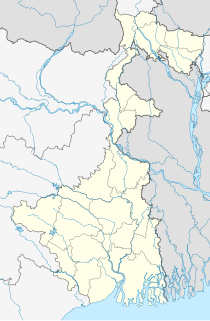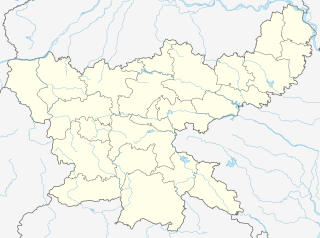Related Research Articles

India is the second most populated country in the world with nearly a fifth of the world's population. According to the 2019 revision of the World Population Prospects the population stood at 1,352,642,280.

Languages spoken in India belong to several language families, the major ones being the Indo-Aryan languages spoken by 78.05% of Indians and the Dravidian languages spoken by 19.64% of Indians. Languages spoken by the remaining 2.31% of the population belong to the Austroasiatic, Sino–Tibetan, Tai–Kadai and a few other minor language families and isolates. India has the world's fourth highest number of languages (447), after Nigeria (524), Indonesia (710) and Papua New Guinea (840).

Bagheli or Baghelkhandi is a Central Indo-Aryan language spoken in the Baghelkhand region of central India.

The Hindi Belt is a linguistic region encompassing parts of northern, central, eastern and western India where various Central Indo-Aryan languages subsumed under the term 'Hindi' are spoken. The Hindi belt is sometimes also used to refer to nine Indian states whose official language is Standard Hindi, namely Bihar, Chhattisgarh, Haryana, Himachal Pradesh, Jharkhand, Madhya Pradesh, Rajasthan, Uttar Pradesh, Uttarakhand and the union territory of Chandigarh and the National Capital Territory of Delhi. It is also referred as the Hindi-Urdu Belt by some writers.

Madurai district is one of the 38 districts of the state of Tamil Nadu in southeastern India. The city of Madurai serves as the district headquarters. It houses the famous Sri Meenakshi Sundareshwarar temple and is situated on the banks of the river Vaigai. Thiruparankundram is one of the major tourist place in the district. As of 2011, the district had a population of 3,038,252 with a sex-ratio of 990 females for every 1,000 males. Aside from the city of Madurai, the larger towns are Melur, Vadipatti, Peraiyur, and Usilampatti. It is an important hub for various film shootings. Alanganallur is a popular spot in the district for Jallikattu, as are Palamedu and Avaniyapuram.

Sattur or Saathur is a town in Virudhunagar district in the Indian state of Tamil Nadu. As of 2011, the town had a population of 29,398.
This is a list of Tamil population per nation.

Sengottai is a town in the Tenkasi district, of Tamil Nadu, India. It is the gateway to southern Tamil Nadu and Kerala. Spread over an area of 2.68 km2 with a population of over 26,823, the economy of the town revolves around the cultivation of rice.
Paniya is one of the South Dravidian languages spoken in India. It is spoken by the Paniya people, a scheduled tribe with a majority of its speakers in the state of Kerala. The language is also known as Pania, Paniyan and Panyah. It belongs to the Dravidian family of languages. According to the 1981 Census, there were 63,827 speakers of Paniya which includes 56,952 in Kerala, 6,393 in Tamil Nadu, 482 in Karnataka. Most of its speakers are found in the Wayanad, Kozhikode, Kannur and Malappuram districts of Kerala, and to the west of the Nilgiri Hills in Tamil Nadu.
Lambadi, Labanki or Gor-boli, also called Banjari, is a language spoken by the once nomadic Banjara people across India and it belongs to Indo-Aryan group of languages. The language does not have a native script.
This is a list of States and Union Territories of India by Bengali speakers at the time of the 2011 Census.
The 2001 Census of India was the 14th in a series of censuses held in India every decade since 1871.
The Registrar General & Census Commissioner, India, Dr C. Chandramouli and Additional Registrar General, India, Shri RC Sethi presenting the Report of Census-2011 to the President, Smt. Pratibha Devisingh Patil.jpg|thumb|President of India Pratibha Patil receiving the 2011 Census report from the Census Commissioner C. Chandramouli. The 15th Indian Census was conducted in two phases, house listing and population enumeration. The House listing phase began on 1 April 2010 and involved the collection of information about all buildings. Information for National Population Register (NPR) was also collected in the first phase, which will be used to issue a 12-digit unique identification number to all registered Indian residents by Unique Identification Authority of India (UIDAI). The second population enumeration phase was conducted between 9 and 28 February 2011. Census has been conducted in India since 1872 and 2011 marks the first time biometric information was collected. According to the provisional reports released on 31 March 2011, the Indian population increased to 1.21 billion with a decadal growth of 17.70%. Adult literacy rate increased to 74.04% with a decadal growth of 9.21%. The motto of the census was 'Our Census, Our future'.

Harishchandrapur II is a community development block that forms an administrative division in Chanchal subdivision of Malda district in the Indian state of West Bengal.

Kanksa is a community development block that forms an administrative division in Durgapur subdivision of Paschim Bardhaman district in the Indian state of West Bengal.

Surjapuri is an Eastern Indo-Aryan language spoken in Eastern India including North Bengal, West Bengal, and Eastern Bihar, as well as in Nepal. Among speakers in some regions, it is known as 'Deshi Bhasa'. It possesses similarities with Kamatapuri, Assamese, Bengali, and Maithili.
Dhanbad Municipal Corporation is the civic body that governs Dhanbad, Katras, Jharia, Sindri, and the surrounding areas in Dhanbad subdivision of Dhanbad district, Jharkhand, India.

Rajmahal is a community development block that forms an administrative division in the Rajmahal subdivision of the Sahibganj district, Jharkhand state, India.
References
- "Census shows drop in Assam population". The Hindu . Chennai, India. 30 March 2001. Retrieved 7 October 2018.[ dead link ]
- Sugden, Joanna; Seervai, Shanoor (9 January 2015). "Where Are India's 2011 Census Figures on Religion?". The Wall Street Journal . New York, U.S.A. Retrieved 7 October 2018.
- 1 2 Padmanabha, P. (1987). Census of India 1981: Series 1 India Paper 1 of 1987 - Households and Household Population by Language Mainly Spoken in the Household (PDF). New Delhi, India: Registrar General and Census Commissioner of India. p. 38. Retrieved 3 October 2018.
- ↑ Padmanabha, P. (1987). Census of India 1981: Series 1 India Paper 1 of 1987 - Households and Household Population by Language Mainly Spoken in the Household (PDF). New Delhi, India: Registrar General and Census Commissioner of India. pp. 1–2. Retrieved 3 October 2018.
- 1 2 "Tabulations Plan of Census Year - 1991: Social & Cultural Tables - C-7 : Mother Tongue - C-7 Part A (i): Distribution of the 18 Scheduled Languages". Census of India . New Delhi, India: Registrar General and Census Commissioner of India . Retrieved 1 October 2018.
- ↑ "Tabulations Plan of Census Year - 1991: Primary Census Abstract - Primary Census Abstract Total : Primary Census Abstract Total". Census of India . New Delhi, India: Registrar General and Census Commissioner of India . Retrieved 1 October 2018.
- 1 2 "Census Data Online - 2001: Data on Language - Part A: Distribution of the 22 Scheduled Languages – India, States & Union Territories – 2001 Census". Census of India . New Delhi, India: Registrar General and Census Commissioner of India . Retrieved 1 October 2018.
- ↑ "Census Data Online - 2001: Data on Language - Statement 2: Distribution of population by Scheduled and Other Languages - India, States and Union Territories - 2001". Census of India . New Delhi, India: Registrar General and Census Commissioner of India . Retrieved 1 October 2018.
- 1 2 "2011 Census Data: Data on Language and Mother Tongue - Part A : Distribution of the 22 scheduled languages - India/States/Union Territories - 2011 census" (PDF). Census of India . New Delhi, India: Registrar General and Census Commissioner of India . Retrieved 1 October 2018.
- ↑ "2011 Census Data: Data on Language and Mother Tongue - Statement 2 : Distribution of population by Scheduled and other Languages India, States and Union Territories - 2011" (PDF). Census of India . New Delhi, India: Registrar General and Census Commissioner of India . Retrieved 1 October 2018.